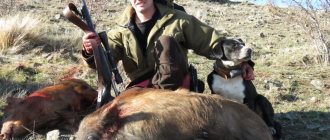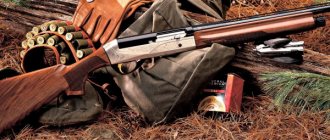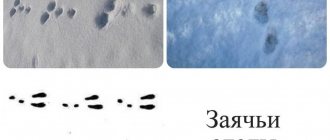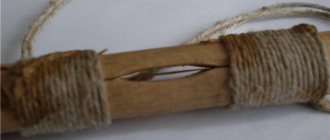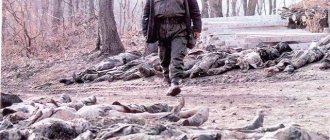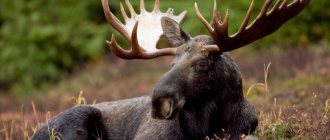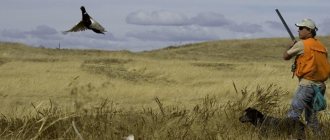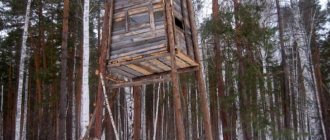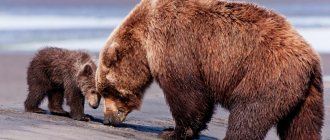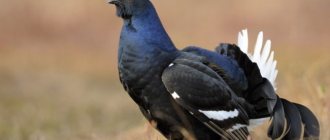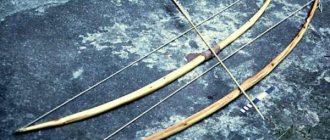One day of hunting in Transbaikalia
The fourteenth of September is Semyonov's day. It’s time for the geese to fly to warmer lands, and for the wapiti to celebrate their weddings.
The commander relented and gave him leave. This is probably the most wonderful time for a hunter, although this is a matter of taste.
In September, the birches are golden and so untouchable: at the slightest breath of wind, yellow leaves drop, and sadness involuntarily creeps into the soul, probably sadness about summer, warm days, which are oh so far away, through frosts, blizzards and various life troubles. The sad crowing of the cranes enhances the feeling of sadness, as if they are leaving their native land forever.
And who knows how their journey will turn out. What a long road they have, how can you not sympathize with them?
But there are no annoying mosquitoes and various bloodsuckers; the morning frosts have tamed their greed. The morning frost invigorates the body and soul of the hunter, you want to quickly walk and walk around all the visible distances with the hope that moose, wapiti, wild boar, and roe deer are probably grazing there.
Ask: “And the hares?” Yes, Transbaikal hunters don’t pay attention to them, they don’t even shoot during a driven hunt. They think: “It’s not worth the trouble, and what’s there, if you stuff a hare, then you can eat the lard and spit out the hare.”
And here I am in the wild forests of Transbaikalia, ten kilometers from the former village of Leskov, there was even a collective farm named after the “First of May”. But the village has not existed for sixty years.
This is interesting: Determining cardinal directions by sunrise and sunset
We arrived in a LuAZ, the craftsmen installed a Moskvich engine on it. The result was passable, light and strong transport. We camped out in a friend’s dugout, near the Boar Spoons. These spoons are so steep that God forbid you fall from the top, you will slide down to the bottom. I really wanted to walk along them in the morning, at the watershed.
A mountain river flows between the dugout and the spoons. When it got dark, I decided to check the birch bark pipe near the fire, which imitates the roar of a wapiti. As soon as the echo of the trumpet died down, the wapiti responded in the spoons. Oh, how inopportunely he sounded the trumpet, it should have been in the morning, because overnight he would figure out what was going on.
“Viktor Yakovlevich, who should we shoot tomorrow?” I ask my friend in power.
“Shoot the wapiti, shoot the gurans, I have licenses, I need to feed the men, how can they live in the forest without meat?” – Victor answered.
In the morning I crossed the river in rubber boots, changed into sneakers - and into the hill.
Expert opinion
Smirnov Alexander Stanislavovich
Wilderness survival instructor. More than 15 years of teaching experience
On the shore I noticed a fresh trace of a wapiti, which meant that he was coming to check who dared to approach His Majesty and the harem. Near the hill, a hole of water in which the wapiti had been was apparently cooling, the thin ice was broken, and small fragments were floating freely.
Having walked about two hundred meters along the watershed, I decided to catch my breath near a clump of wild rosemary, behind which a clear hill opens up. A light frost cools your fingers.
The sun will come out soon, but it will shine on the back of my head - that’s good. I look at the hill through the branches of wild rosemary and see two gurans seventy meters away.
I put the rifle on the Taganka, point the front sight at the guran’s shoulder blades and press the trigger. Guran disappears, and the second, after making several jumps up the mountain, stops, apparently to figure out where to run.
I shoot the second one. He took a leap and rolled over the back of his head like a wheel; this is the first time I’ve seen a wheel with horns and hooves. He was hit in the neck by a bullet and almost missed. I went to the top, I wanted to inspect these spoons.
Every now and then I scare the hazel grouse. I found a fresh litter of wapiti, still hovering, apparently evading the shots.
The sound of a shot came from his comrades. It was Volodya’s friend, when approaching a hill on a forest road, he saw a guran, but missed.
Having examined the “Boar Spoons,” he returned to the place where the Gurans had shot. But there are none. Leaning on the tagankas, he carefully began to descend the mountain.
A hundred meters from the place where he shot, I found both. One had its horns broken off and the skin in the sacrum area torn off.
This is apparently the one that rolled like a wheel. He gutted it and went to the dugout for his comrades.
They were already drinking tea that was strongly brewed and whitened with cream. After steep hills it is so tasty, it will quench your thirst and restore your strength.
Volodya explained to Victor why he missed the gurana: he shot from hand, there was no time to move the Tagankas, with which he, of course, would not have missed.
I won’t lie, I really didn’t want to leave this beautiful place. Literally near the dugout you could enjoy bunches of red lingonberries.
Along the forest road, overripe blueberries hang on small bushes like purple lanterns, like tiny barrels of nectar. In a word, a paradise for a hunter, but so distant and difficult for permanent residence.
But let's not talk about difficulties.
The East Asian wapiti is one of the most famous subspecies of red deer, also popularly referred to as “real deer.” This graceful and luxurious animal is a desirable prey for any hunter.
However, in addition to its stately and majestic name, the mammal is also extremely cautious, so getting it for a novice fisherman can be very problematic. But if you properly prepare for the event, having studied the habits of the animal and the main methods of hunting wapiti (by roar, on salt licks, from the approach), then the hunt will almost certainly turn out to be a great success.
This is interesting: Dog attack: causes, actions, defense options
Roar hunting: Red deer
| If we talk about roar hunting, then for me there is no better hunt. When in the darkness of the forest an animal starts its song and screams so loudly that the UAZ doors shake, you can feel a wild surge of adrenaline. It is impossible to get used to this sound; you want to listen to it again and again. Waiting for the beast to come to the pipe - such moments are worth a lot. |
So the idiot's dream has come true. I caught a wapiti during the rut. I chased the beast for two days. It was worth it. A fighting bull, however. The left horn is broken off, there is a hole between the ribs, the knee is yellow - a solid bruise. The hole between the ribs is visible only when cutting, as is the bruise on the leg. The skin is intact, but there is a hole between the ribs that has already healed, but it is clear that the guy recently fought. In general, a serious, fighting bull. Roughly 5-6 years. I don’t know the exact weight, but they brought home 208 kg. Fat horror, well, it’s because the rut has begun. Usually bulls lose all their fat during the rut. No time for food.
If I say that I got the bull in one person, then I will be deceiving. We hunt together.
We got this animal using the classic method. I describe: We find a preoccupied guy. To do this, we stupidly trumpet in the places of its usual habitat. Sometimes you just hear it, especially in the morning. That’s where such screams are heard, and that’s where we go.
The animal was found km from the main road. Old cuttings. They blew it at 10 pm, he responded. However, after about forty minutes it began to go deeper. There was a carload of time, so we decided to take a ride and look for a braver guy.
Here’s the thing: the young animal is afraid to run to the tune, hesitates, and even if it responds, it’s worth going to it, and moves away. Constantly maintains a distance of three hundred meters. But adult wapiti are much bolder. Therefore, in places where there are a lot of people trumpeting, an adult bull is rare. Runs into a bullet easily.
We drove 12 km to a familiar place, where two or three bulls usually roar. It turned out the place was already occupied, dogs were barking not far away. Izba. We thought there would be no one there on Thursday. We drove to the place and heard the dudars. A bull answered them through the gap. A kilometer in a straight line. Apparently they heard us and decided to show that the place was already full. We turned around and went to the main one.
Fuck you guys. We'll take the bull away. They got into the habit of strangling animals with dogs. We take out a weapon in the form of a cunning device from a tin can and a pipe. Bulls are good at this organ. We drive around the animal from the side and start blowing. Filled with nightingale. Closer, closer... Silenced. We wait. Half an hour later the bull was already very close. Horns knock on the bushes. Quietly he came up completely, crossed the road and came towards us.
Night. The gypsy sun has just risen, quarter. Generally dark. But we have an under-barrel flashlight.
I take off my shoes and come closer along the way. My feet are getting cold. The temperature outside is sub-zero. But I can hear the animal sneaking around. But he doesn't yell. Breathing. I climb onto the dump, and there is a chepyga. A clearing is a place that is overgrown with bushes within five years. The beast has plenty of freedom, the food supply is excellent. But for hunting it’s terrible.
In short, we breathed on each other and went our separate ways. My partner tried to move further away, etc. etc., but the beast apparently knocked me out. Maybe it was blown by the wind. I didn’t dare look for him with a flashlight. I thought the beast would reveal itself and come closer. But no. The animal responded ten minutes later, far from the road. And screw him. But the competing company failed. And that makes me happy.
But since the animal is responding and the whole night is ahead, and the places are familiar, we continue the hunt. We decide to take a detour around this red deer. A 12 km detour is nonsense. We drive around and find ourselves in fresh clearings. We blow. The bull responds. According to the navigator - our bull, which was lured away. Well, we decided that it was him.
All attempts to pull the guy out into the clearing or at least move him from his place were unsuccessful... They threw sleeping bags and let’s dragon him. It responds well, but it costs. We decided to approach him in the morning, it would be dark, and then, when it was dawn, we’d figure it out.
It didn't work out. Chepyga is creepy. There is no way to walk through the dark. At dawn we saw that the bull had occupied the navel, around which there were eerie thickets of willow grass. Feeling upset, we went to sleep.
The second day has begun. Depression. This is how it happens every time, something breaks off.
12 a.m. We arrived at the trailer. We make tea. We're going to get some sleep and go back to battle. I hear the wapiti yelling. It’s so rare to hear a bull at this time... But it’s yelling. We respond. Oh, the bull makes such trills. We go to bed, postponing the bull for the evening. Well, at least you don’t have to look for it, and that’s nice.
In the evening, around six, we go into the forest. The bull didn't go anywhere. Now this is definitely a worried bull. After yelling all day, he became completely aggressive in the evening. But it doesn't work out. Let's go forward and dragon. About three hundred meters away I find a place for an ambush. The partner inflates the bull and moves back. While it’s light, I come very close, like a wood grouse.
It's getting dark. The bull is as if tied. Doesn't work. My partner went 700 meters back. I'm a hundred meters from the beast. It’s dark, I don’t dare approach, I’ll make some noise. At one o'clock in the morning I give up the idea.
The bull screams fiercely for another half hour, then calms down. We go to bed before five in the morning. I’ll take a detour to reach the creek, leaving the beast between us.
I'm coming. The partner inflates the animal and then three more wapiti join in. They approached silently at night. But since we are doing this, I don’t pay attention to others. I walk about 500 meters with a flashlight. I turn around. About a hundred meters away a “Wow” is heard. This beast approached quietly and barked at me. The flashlight detected it. It worked out. Our handsome guy yells obscenities.
I'm getting closer to the beast. About three hundred meters away I take off my shoes and in woolen socks I sneak towards the beast. Fortunately, the rain soaked the grass and leaves. Legs give oak. I approach, the beast moves away. 300 meters have already been covered, but the animal seems to sense me and moves away. I go out to the edge of the forest. It's getting light. The beast screams opposite. We are separated by a mokotina, an open wetland. You can't go any further, he'll see.
I throw my hat down my ass and sit down to wait. Light. It's frosty. Legs give oak.
In the forest, the animal runs in circles, you can hear the branches crumbling. I am waiting. The partner fell silent. Uses different tactics, like “Hey, where is everyone”?
The bull is rampant! Naturally, the thought that your partner has given up on hunting and gone to bed comes to mind at such moments. But we are a team. Forty minutes later I hear a trumpet. Not sleeping.
The beast comes onto the stage. Calmly, confidently, he walks straight towards me. I'm surprisingly calm. I'm waiting for him to come closer. I raise the barrel, getting ready to shoot. The bull stretches his neck. Did you really notice? This is where my nerves get worse. It's uncomfortable to shoot while sitting on your butt. The trunk twists his arms, and then there’s steam coming out of his mouth. The bull, after sniffing the air, relaxes.
I lower the barrel, breathe regularly, try to calm down. I'm waiting, I'll shoot for sure. The animal turns sideways and puts out a shoulder blade. Starts a song. I'm aiming. Shot.
Jump - and the animal inspects the place of danger on the move. I jump up and aim the guy. The second shot, and the beast disappears into the mokotine. I'm running. Hoping for one more shot. Will he really leave?
The handsome guy is lying down. Hit in the neck, right next to the ball, in the spine. The red deer passed away into another world without suffering. Luck.
To celebrate, I give a signal to my partner - two shots in a row. Near the ear. Well, aren't you an idiot?
I’ll skip dancing with a tambourine and cutting. But I took a photo of the bullet. I found it under the skin. Didn't go through. A good bullet, semi-jacketed. The beast falls off it well.
But the first shot confused me. Past. I shot from 70 meters. I attribute the miss only to the branches that were between us. He aimed at him clearly, calmly. But if the beast had not been stopped by the second shot, he would have been tormented that the wounded man had escaped. I really don't like wounded animals. You can search by blood with a dog, but you still don’t know whether you hit it or not. It’s not a problem to destroy an animal, but it didn’t live to be torn apart by crows or bears.
That's all. The hunt was a success. Now I'm going to hunt wild boars...
tgp-75.ru
Other articles on this topic:
- Hunting in the Khabarovsk Territory: Geese - Bears - Manchurian deer
- Hunting for wild boar and wapiti is open
- Game wardens and rangers of Primorye are preparing for the hunting season for wapiti
- A. Formozov, Pathfinder's Companion: Elk, Deer, Roe Deer, Musk Deer, Boar
- Decoy for deer
- Moose hunting on wabu with a Professional. And some features of hunting large ungulates
- Moose decoy: Hunting with a decoy for moose - hunting for wabu
- Experienced: Hunting Hunters
Red deer - way of life and habitats
The main habitat of the wapiti is the Far East and Transbaikalia (the region of Eastern Siberia east of Lake Baikal). Also, this type of red deer is often found in Yakutia.
Expert opinion
Smirnov Alexander Stanislavovich
Wilderness survival instructor. More than 15 years of teaching experience
The animal lives mainly in forest areas, preferring mountain broad-leaved or taiga areas. Red deer can often be found in sparse areas of mountain undergrowth, but only if a river valley runs along them.
In the summer, the red deer reaches the alpine belt, but as soon as the soil underfoot changes to snow, the red deer stops migrating. In addition to Russia, the animal can also be found in China and North Korea, but the mammal became most famous among hunters in Transbaikalia, since here the skin, meat and fat of the red deer are most valued.
The main behavioral feature of the red deer is that it is far from the stupidest animal. At the right moments, the wapiti can show extreme caution and sensitivity, and in some cases even some semblance of cunning. However, there are still certain time frames when such qualities of the animal are somewhat dulled. This happens during the mating season, when the deer begins to court its harem.
Features and habitat of wapiti
The wapiti animal is probably one of the most luxurious types of deer. Its amazing color attracts attention, smoothly turning into red-red near the tail. This is the color of red deer in the summer.
In winter it turns silver-gray. The average body length of a red deer animal reaches about 2.5 meters. But sometimes there are wapiti, the length of which can be 2.8 meters. These parameters apply to males. Their females, as a rule, are always smaller.
The horns in the photo of the red deer are very reminiscent of a beautiful crown. Their size in span is about 80 cm, length is 90 cm. They are not as branched as those of a reindeer, but it happens that they have about 16 branches.
It is believed that the number of twigs can help determine how old an animal is, but this is only possible up to a certain point. The older he gets, the fewer branches there are the red deer’s antlers
With the arrival of spring, the animal sheds its horns, leaving only small growths in their places. After two months, new horns appear, which annually increase by one process, called antlers.
Initially, the antlers were made of soft, velvet leather. But some time passes, and they lose their velvety skin and become ossified. Young antlers are a very valuable material used in medicine.
It is during the period from May to June that these animals become the most desired trophy of hunters. Red deer meat, its fat and skin are no less valued hunting for red deer is quite a frequent and widespread occurrence. But everything happens strictly according to the license, with all the necessary time restrictions.
The animal's head is slightly elongated. The neck is not long, the ears are medium-sized with pointed tips. Its coloring is characteristically uniform, there are no spots on it. Young ones can be spotted until the first molt.
Red deer live in forests. Most of all he likes taiga, broad-leaved and mountain forests. It can be found in sparse areas of mountain undergrowth, along river valleys.
In summer it reaches the alpine belt. The main thing for red deer is that it has solid ground under its feet. This beautiful animal lives in Russia, the Far East and Transbaikalia, Yakutia and Primorye, as well as in Korea and northern China.
Differences between hunting in spring and autumn
The mating season for red deer begins in early spring, when most of the forest surface thaws from snow and is also covered with the first young greenery. At this time of year, deer are quite easy to track by following their tracks, since they move mainly on flat terrain.
Complicating the prey is the fact that it can be difficult for a hunter to hide in open space. As a result, you have to either use an optical sight or look for natural cover.
In the spring, wapiti are shot primarily for their valuable antlers, which cost between 5,000 and 7,000 rubles per pound (total weight 10 to 15 pounds). However, if you delay fishing until June, the trophy will lose its value because it will quickly dry out and crack.
As for the skin, in the spring it is not of particular value, since the males begin to shed heavily after the winter period.
Red deer antlers are valued in the spring; in the summer they become fragile and lose value.
In summer, wapiti are usually not hunted, since during this period the trophy value of horns, skin and meat is minimal. In addition, during extreme heat, the red deer begins to stay closer to lakes and swamps, and during watering the animal shows extreme vigilance, so that it is almost impossible to get close to it.
Autumn is the most favorable time of year for hunting red deer for meat and skin. The fact is that it is during the period from early September to mid-November that the mammal stores fat for the winter, and also grows a dense layer of fur. It is in the fall that the mating season begins not only for adult males, but also for young deer, so the likelihood that prey will respond to the decoy is extremely high.
In winter, hunting for wapiti with hound dogs and skis is quite common. However, such an event will require at least 4 people, as well as several dozen dogs. However, it is in winter that red deer meat has the greatest value, since it loses most of the fat and is overgrown with muscle fibers.
This is interesting: Tin and glass tin cans: how to open with and without an opener
Royal hunt – hunting for wapiti
→ Hunting and Fishing
From early spring to early summer, hunting for red deer continues. The open mountain slopes are covered with young green grass, as the snow melts first from the high mountain slopes facing the sunny side. When other areas are cleared of snow, the animal moves to new places and can only be found by following the trail left in the mountains. Red deer can easily escape the hunter in cloudy weather when he is grazing on steep slopes. The trail of the animal disappears (gets lost) very quickly. In early spring, hunters track the animal on the crust. Moving on skis, using hunting dogs, they drive the animal and shoot it. It should be noted that in the spring they hunt wapiti, gathering in small groups (from four to eight people). In any case, the equipment at this time of year must be appropriate, as there is a danger of hypothermia.
During the spring hunting season for wapiti, the main goal for the hunter is to obtain horns. In spring (March-April) males get rid of old horns. New horns grow in their place. For 62 days after emergence, the horns will be soft and covered with skin. They are called antlers until the moment when they ossify, that is, they become hard (boney). The mass of antlers is approximately 4 to 6 kilograms. The most valuable for a hunter are the horns that are caught within one month: from the last week of May to the last week of June. It is believed that from the third decade of July, the antlers of red deer dry out and lose their value. They sell the antlers and receive a large material profit. Hunters keep the skin of the animal for themselves as a souvenir, and use the meat for food, making various delicacies. Red deer meat is considered one of the most excellent products. Hunting for wapiti continues in the summer. You can find the animal near lakes and wetlands.
The autumn hunting season for wapiti begins in mid-September. At this time, the females begin to go into heat. The leader male, surrounded by females, begins to roar, calling with this roar other males to fight - a duel. Another male, claiming the female, rushes to this sound in order to enter into a duel and prove his right to own the female. As it approaches, it makes the same roar. During the fight, the females stand aside, watching the fight between the males. Males lock horns (in autumn, the horns of wapiti become branched and strong). Thus, they compete against each other, but do not try to kill each other. The fight itself is like a purely symbolic dance of two huge and beautiful animals. The defeated male runs away, and the winner remains with the females. Males roar from dusk until dawn. This is the best time to hunt animals: before sunrise or after sunset, at dusk. And knowing this, hunters use a decoy - a pipe about seventy centimeters long with a slight slope. The roar of a male is depicted using a trumpet. Decoys are made from wooden reels, film and other materials. There are many options for making a decoy, but the main thing is that the pipe should make a sound that attracts an angry male.
For a successful hunt, the hunter must find the place where the fight between males takes place. It is given away by trampled grass, ground knocked out by hooves and stripped trees. Several people gather for such a hunt, usually three hunters. Each of them has its own task: one gives a voice into the trumpet, while he can stand or run back and forth, making a roar. The other two hunters are shooters, they are located at a distance of about a hundred meters from the “howler”. Seeing the beast approaching at the roar of the trumpet, they must shoot immediately. With this method of hunting, you can hunt an animal for one month. When the first snow falls, red deer are harvested based on the first powder. The animal's tracks are clearly visible in the snow.
The hunt for wapiti is called the queen of hunts.
Published: 10/11/2013 Tags: Red deer, Deer, Hunting, Hunter
© Copying of material is permitted only with an active link to Readmas.ru
← Previous article Next article →
Add a comment Cancel reply
RELATED ARTICLES:
Features of pike fishing
African safari for outdoor enthusiasts
Successful fishing on trout lake
Preparing for the hunt
About types of hunting
Features of autumn fishing - how not to be left without a catch
Mongolian girl and eagle
Donkey fishing. Minimum Required
Hunting the roar
Hunting for deer by roar is the most popular way of hunting large ungulates not only in Russia, but also in America, as well as Canada. The red deer in this regard is no exception, since it is during the mating season that the males relax their vigilance towards humans and begin to actively look for a female for mating, and also defend their territory in the fight with other males.
At the same time, the roar of the wapiti cannot be confused with anything - a drawn-out moo inviting another male to a duel. And the older the male, the rougher his voice will be.
Hunting for wapiti
They begin to hunt wapiti from May until the onset of hot summer days. In early spring, red deer are hunted on open, high slopes covered with young grass. These slopes are cleared of snow earlier and are the first to become covered with greenery. Somewhat later, when all the snow has melted, they begin to search for wapiti in the mountains by following the trail. If you manage to track a wapiti in an open, flat place where you can easily sneak up and if the weather is good, then “you can kill the wapiti.” If he stands on a steep place and the weather is bad, there is no point in sneaking up on him: “he will leave anyway and his trace will be lost.” We'll have to look for traces again.
Differences between hunting in spring and autumn
In spring, the main goal of hunting wapiti is to get antlers. The average weight of Sayan wapiti horns is 10-15 pounds (4-6 kg) with a price of 5 to 7 rubles. £1 for good quality horns (1925). Of great value are the horns taken from the animal between May 20 and June 20; after this period, the horns begin to dry out and quickly lose value. By June 20, the horns have no value and are sold for next to nothing, as an ornamental material. In the summer, wapiti are found in lakes and swampy areas.
On September 15, the autumn hunt for wapiti begins using a “decoy” - a special pipe with which the male’s roar is imitated. This time coincides with the estrus period for wapiti. Hearing the war cry of his opponent, the wapiti goes to fight him. Approaching the hunter, the wapiti responds with a roar to the sound of the trumpet, thereby warning the caragas of its approach. The “roar of the beast” lasts one month, i.e. until October 15. At this time, the period of early autumn snow begins. There is some time left before the start of the fur hunt, which is used to beat the wapiti “in the powder,” i.e. tracking through the snow.
In addition, they beat the wapiti in early spring on the crust, driving it with dogs on skis. And a little later, when the snow melts, in the spring powder. Rare dogs are able to drive wapiti to the sludge. On the crust, they also hunt for antlers with dogs, but at this time the antlers are just beginning to grow. Hunting for wapiti in the spring (the wapiti horn is obtained) is usually carried out in a cooperative manner. Artels sometimes consist of 8 people; rarely less than 4. The skin of red deer is not sold. It is used to cover yurts. Red deer produce good quality meat of at least 5 pounds.
Hunting the roar
Roar hunting is popular not only in Siberia and Lake Baikal, but also in America and Canada. Wherever there are deer, where they are hunted. And each deer has its own special roar - the deer and the European deer have their own “voice”. But in terms of the beauty of the roar, and all hunters agree with this, the roar of the Baikal wapiti, the most beautiful and powerful representative of the deer family, is the most beautiful.
New horns, new battles. For a male wapiti, horns are one of the main indicators of his genetic capabilities for further procreation. In the spring, in March-April, male wapiti shed their old antlers, and in early May they begin to grow new antlers - antlers. They are soft for the first two months and by the end of July they ossify and the skin peels off. And in the fall, the male wapiti with new magnificent branched antlers is ready to engage in fights with his relatives. With a loud roar, he gathers a harem of females near him. Usually, there are 3-4 of them, however, sometimes there are up to 10. Male wapiti, with their loud roar, which cannot be confused with anything, challenge each other to a duel. Moreover, the older the male, the larger he is, the rougher his voice. The females stand aside all this time and watch. Male wapiti do not try to kill each other during a fight. They, locking horns, seem to be measuring their strength, finding out who is stronger. Throughout the forest, these blows of horns and the wheezing of angry rivals can be heard. The bull that turns out to be weaker feels this and has to retreat. The winner stays with the females. Such a struggle for females occurs every year in the fall.
Hunting for wapiti “by roar” begins when the first frosts occur, from September 15 to October 15. Bulls roar from evening until sunrise. It is at this time that you need to hunt them. To hunt wapiti “by roar,” they use special trumpets, the sounds of which are similar to the roar of a bull. They are made from cedar wood, from twisted birch bark, they can be made from a wooden spool on which threads are wound, from film, or from tin. Every hunter has his own secrets about this. They blow into these pipes from themselves, exhaling air, or suck it into themselves. The main thing is that the sound they make resembles the roar of a wapiti. Finding the best hunting spot requires observation. Bulls, preparing for fights, scratch their horns on trees and butt small fir trees. In these places the ground is always knocked out by hooves and the grass is trampled. As a rule, they do not hunt “roar” alone. The optimal option is when one of the hunters “roars” into a trumpet, and the other two are nearby with guns at the ready. In many ways, the success of hunting wapiti “by roar” depends on the hunter who directly roars into the trumpet. He must be able to correctly depict the sound in order to call the male, and orient himself correctly. There are various ways to lure out a wapiti bull. You can just use your voice, or you can first use your voice, then run a little forward, raise your voice, and come back, showing that the opponent got scared and ran. At this time, shooters with guns move 100 meters away from the “howler” to see the approach of the beast. As soon as they see it, they shoot. It is especially beautiful to watch a wapiti following the sound of a trumpet on a clear frosty morning at sunrise. The bull walks majestically, breathes, clouds of steam rise from it... An unforgettable spectacle!
It also happens…. It happens that predators, for example, bears, who are also not averse to indulging in red deer meat, also come to the sound of the trumpet. Moreover, bears actively hunt during this period before hibernation. Here both the male wapiti and the hunter need to be on alert.
Fights among males
The hunter must understand that during a fight between two males, there may also be from 3 to 5 females next to the animals who have come to the call of the wapiti. Shooting females is strictly prohibited for obvious reasons.
The fight itself is reminiscent of an arm wrestling competition, only instead of hands, horns are used here. The bulls butt until one of them becomes exhausted and falls to the ground.
Usually after this the defeated opponent makes an angry wheeze and the fight ends. And although during the fight both males may suffer from sharp blows from the horns, neither of the two deer sets itself the task of killing the opponent.
